Project details
Skill
Cost
Estimated Time
It may seem daunting at first, but with the right tools and guidance, hanging a door is achievable for many do-it-yourself (DIY) enthusiasts. A prehung door comes preassembled with the door hanging on its frame, making installation more straightforward than hanging a door from scratch. This guide will walk you through the process step by step.
Understanding Prehung Doors
Prehung doors offer several advantages over traditional door installations, making them popular for both new construction and remodeling projects.
What Is a Prehung Door?
A prehung door is a complete door unit that includes the door, slab, and hinges so they’re ready to be installed in a doorway. This reduces the time and effort of installation, as much of the complex work of fitting the door to the frame has already been done at the factory.
Benefits of Prehung Doors
Prehung doors offer several advantages over traditional door installations:
- Precision: Factory assembly ensures a better fit between the door and frame.
- Convenience: Saves installation time for new construction or when replacing both the door and frame.
- Consistency: Provides a uniform look, especially when installing multiple doors.
However, while prehung doors simplify installation, they still require careful adjustment to account for variations in wall framing. As This Old House’s Tom Silva cautions, “It requires accuracy to put in one of these. If it’s not installed right, it won’t hang well.”
Common Mistakes To Avoid When Ordering Prehung Doors
Back when carpenters assembled the parts around a door piece by piece, they could easily customize their work, make changes, or correct problems. With a prehung door, however, most of the assembly work is done off-site, so a mistake made when you place an order can turn a perfectly good unit into worthless scrap. Here are two steps for avoiding that outcome.
Know your opening: Prehung doors are made to fit rough openings 2 to 2 1/2 inches bigger than the corresponding dimensions of the jamb. The jamb’s depth should match the thickness of the wall, including the plaster or drywall. If the opening already exists, check that the trimmers are plumb, parallel, and square to the wall and the header. If they aren’t, read “Troubleshooting Common Issues” below before you order.
Specify the swing direction: Your supplier needs to know which way you want the door to swing, but beware of the question, “Do you want a left-hand or a right-hand door?” Those terms don’t always mean the same thing. So rather than answering directly, say instead which side you want the knob to be on when opening the door toward you. Let that person figure out what the door’s “handedness” is.

Prehung doors hang on a jamb that is “split” into two pieces. The door is attached to the main jamb, which is installed first. The split jamb has a groove under the stop so it can slide over the edge of the main jamb. Typically, both jambs are furnished with casings already attached.
Parts of a Prehung Door
Knowing the specific names of each part of the door can help you in both the ordering and installation process. The diagram below labels each part of a prehung door and the areas around it.
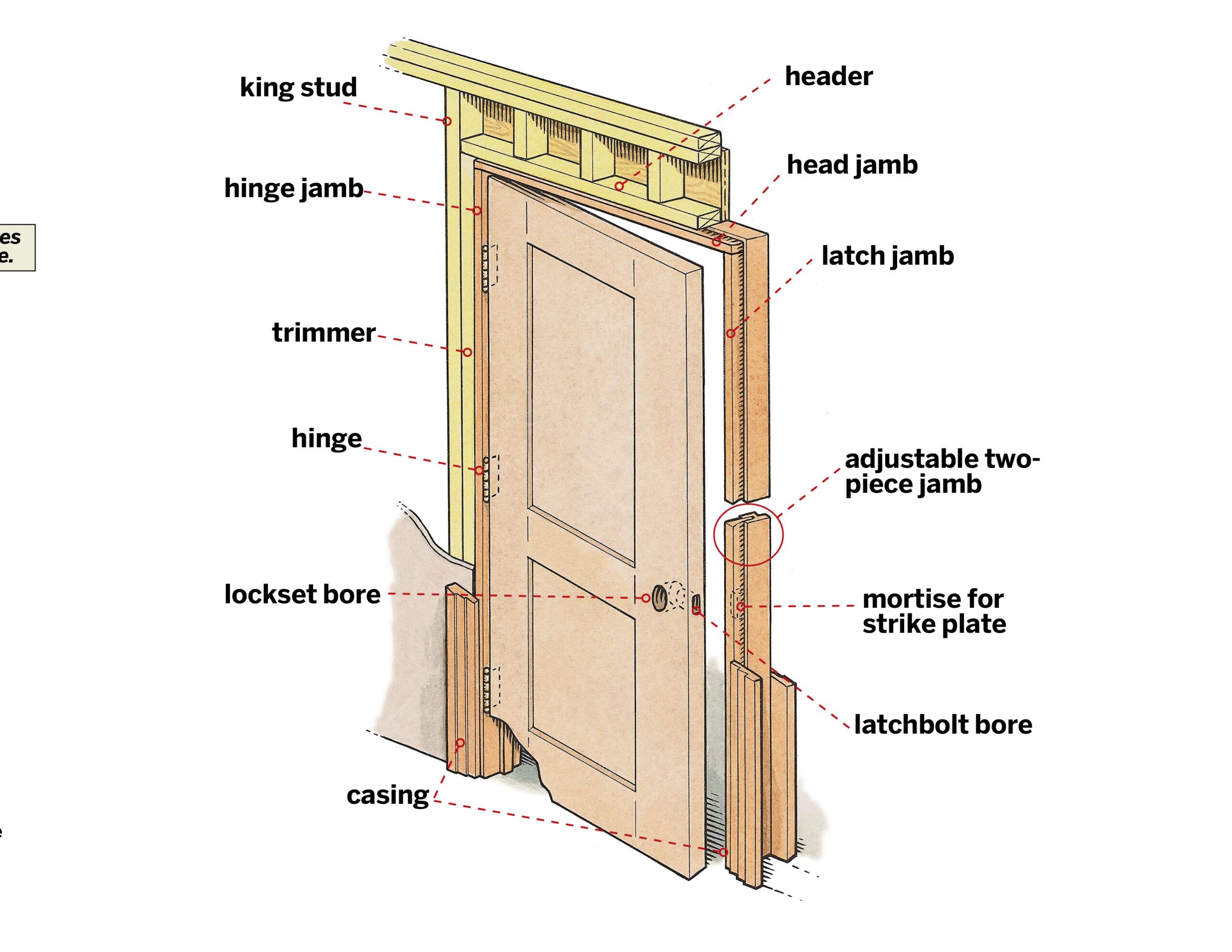
Tools and Materials Needed for Prehung Door Installation
Many of the tools that you’ll need to install a prehung door are ones that you likely already have in your toolkit. However, there are a few specialized tools that you’ll need to ensure your work is accurate.
Essential Tools
To install a prehung door, you’ll need the following tools:
- 4-foot level
- Hammer
- Utility knife
- Pry bar
- Screwdriver (both flathead and Phillips)
- Drill with bits
- Chisel
- Plumb bob
- Tape measure
- Pencil
Required Materials
In addition to the prehung door unit itself, you’ll need the following items:
- Shims (cedar or composite)
- 8d finish nails
- 3-inch screws
- Wood filler
- Caulk
- Sandpaper
1. Prepare for Prehung Door Installation
This phase involves carefully measuring the rough opening and ensuring it’s plumb and square. Taking the time to prepare correctly will save you headaches later in the process.
Remove the Old Door (If Applicable)
If you’re replacing an existing door, you’ll need to remove it before installing the new prehung unit. This process involves carefully detaching the old door, frame, and any trim to prepare the opening for the new installation.
- Start by removing the door from its hinges. You may need a screwdriver or drill to remove the hinge pins.
- Next, remove any trim or molding around the door frame. Use a utility knife to score along the edges of the trim to prevent damaging the wall when prying it off.
- Remove the old door frame. This may involve cutting through nails or screws with a reciprocating saw.
- Clean up the opening, removing any debris or protruding nails.
Remember to work carefully to avoid damaging the surrounding wall or floor. If you’re installing a door in a new opening, you can skip this step and move directly to installing the prehung door.
Measure the Rough Opening of the Door
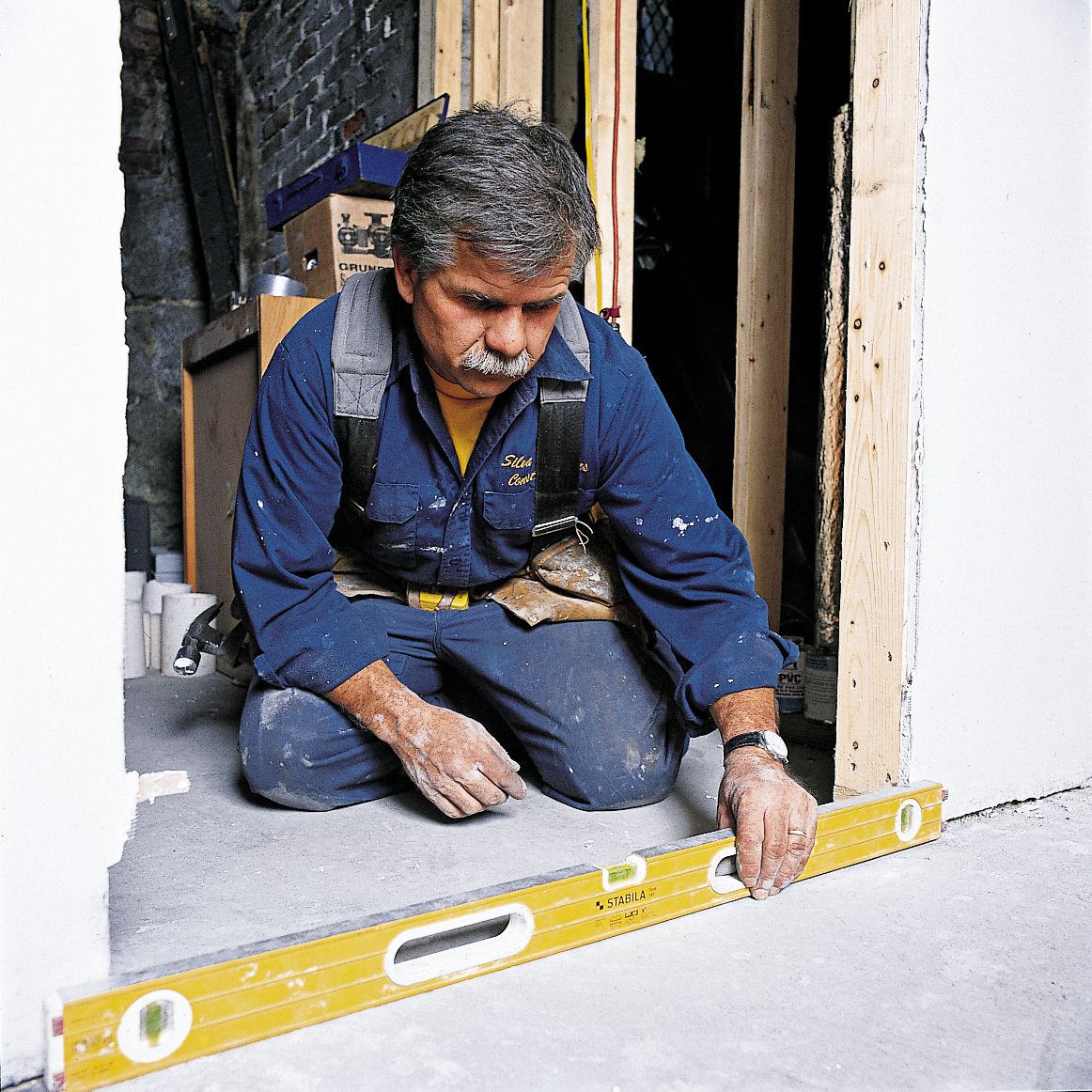
Before buying a prehung door, you’ll need to measure the rough opening accurately. Prehung doors are made to fit rough openings 2 to 2 1/2 inches bigger than the corresponding dimensions of the jamb. Here’s how to measure:
- Measure the width at the top, middle, and bottom of the opening.
- Measure the height on both sides and in the center.
- Measure the thickness of the wall, including drywall or plaster.
- Use the smallest width and height measurements when ordering your prehung door to ensure it will fit.
Check for a Plumb and Square Door Opening
A plumb and square opening is crucial for proper door operation. Here’s how to check:
- Place a 4-foot level on the floor in the doorway. If the hinge side is lower than the latch side, slip shims under the level nearest the hinge jamb. Adjust until the level’s bubble is centered.
- Tack the shims to the floor with a finish nail. If the latch side is lower, no shims are needed.
- Check the walls and the trimmer studs for plumb using a level or plumb bob. Also, check the trimmers’ faces with a framing square to see if they are square to the wall.
- Finally, check that the trimmers are parallel by measuring between them at the top, bottom, and middle of the opening. If the wall is out of plumb, or the trimmers are out of plumb, out of square, or not parallel, you’ll need to make adjustments before installation.
Shim the Trimmers
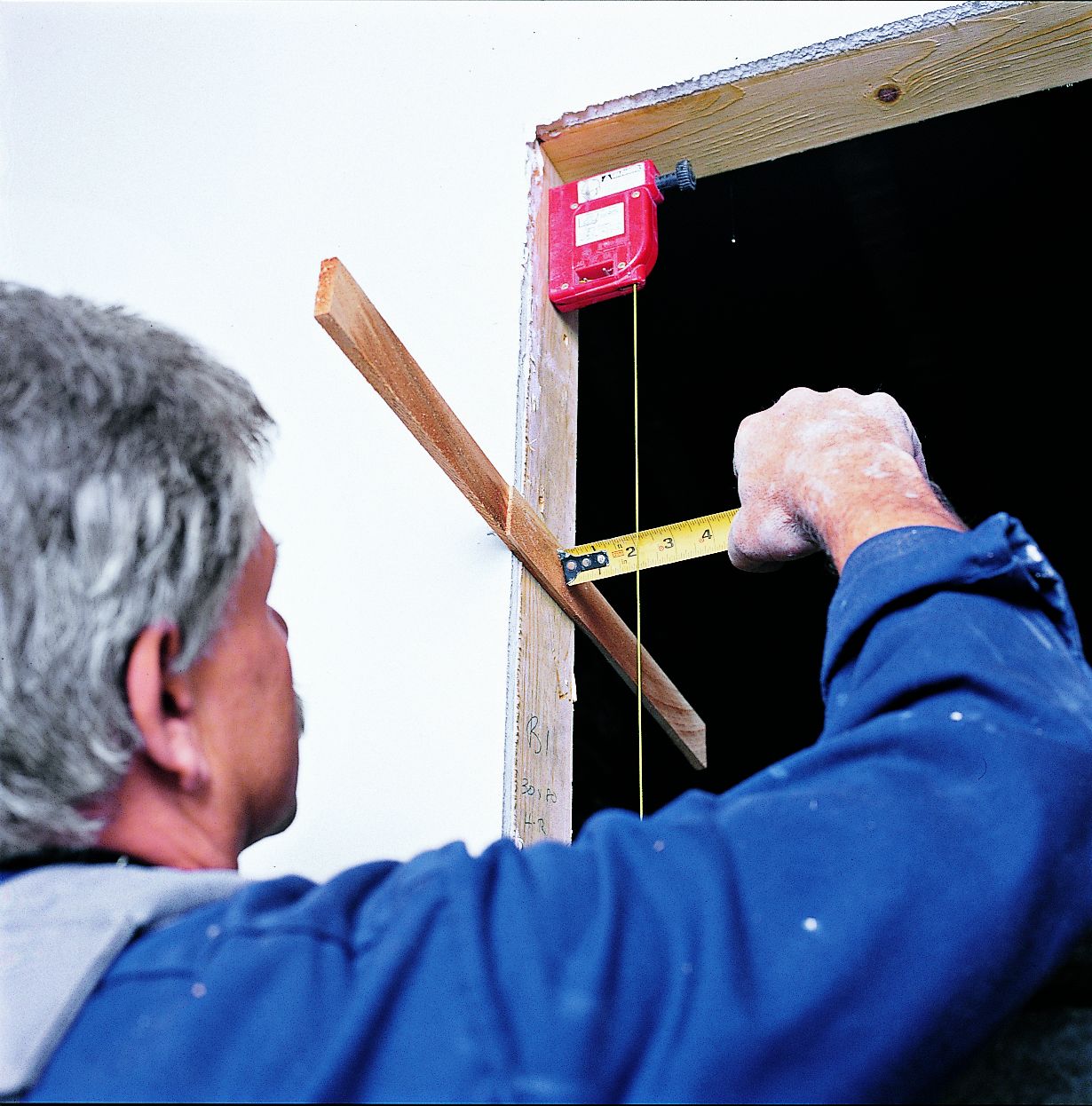
- On the hinge jamb, measure from the bottom of the jamb to the center of each hinge. Mark the hinge locations on the hinge-side trimmer by measuring up from the floor (or top of the shims).
- Tack the plumb bob to the top of the hinge-side trimmer and measure the gap between the string and the trimmer at each hinge location. Where the gap is the smallest, place overlapping shims.
- Adjust the shims to 1/8 inch thick, and tack them with a finish nail. Measure the gap between the shims and the plumb bob string.
- Place overlapping pairs of shims at the other two hinge locations. Adjust each pair’s thickness until the gap between shims and string equals the gap at the first pair.
- Nail each pair to the trimmer and cut off the ends with a utility knife so they don’t protrude past the drywall.
2. Position the Door in the Opening
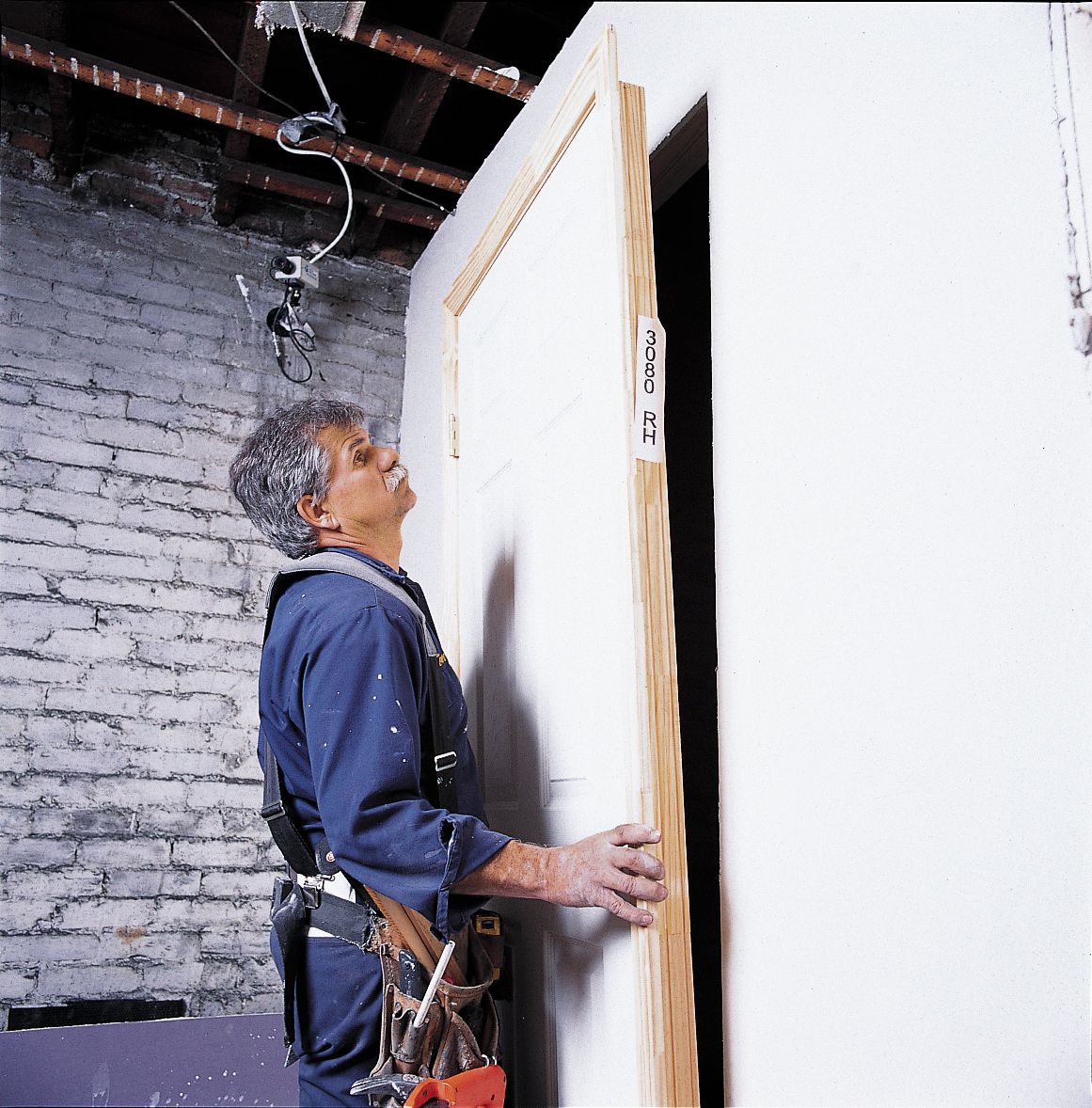
- Lift the door into the rough opening and push the hinge jamb tight against the shims tacked to the trimmers. It’s often easier to do this with a helper.
- Tack an 8d finish nail through the face of the hinge-side casing 3 inches below the miter, into the trimmer. Hold a level against the face of the casing and adjust the jamb in and out until plumb.
- If the wall is plumb and the casing rests flush against it, tack 8d finish nails through it at the other two hinge locations.
- If the wall is out of plumb and the casing does not rest against it, shim behind the casing at the hinge locations to make the door plumb.
- Nail through the casing and shims and into the trimmer. Fill any gaps between the casing and the wall with tapered wood wedges.
3. Adjust and Align the Door
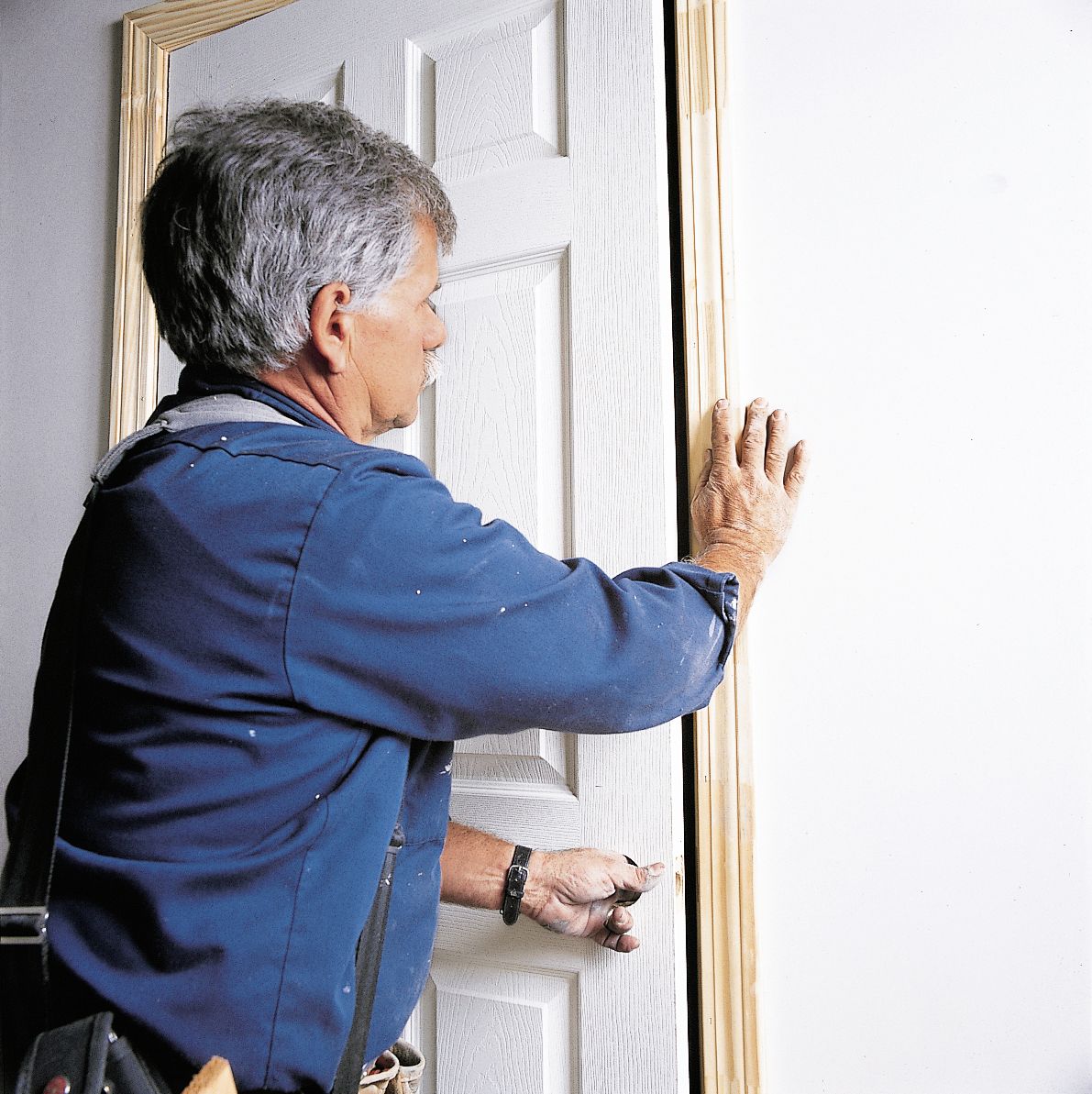
Set the Reveal
- Check the horizontal gap, or “reveal,” between the top of the door and the head jamb. It should be uniform from left to right and 1/8- to 3/16-inch wide.
- If necessary, adjust the reveal by pushing up the head casing. Set this reveal by driving an 8d nail through the face of the latch-side casing and into the trimmer, near the top of the door.
- Check the vertical reveal between the door and jamb on the latch side. It should be about the thickness of a nickel. To adjust it, grab the casing and move the jamb by hand.
- Open and close the door to check that its leading edge, the one that rests against the stop, clears the jamb by a consistent 1/8 inch.
- Set the reveal by driving 8d finish nails every 16 inches through the latch-side casing and into the trimmer. Make sure the reveal remains consistent.
Ensure Proper Swing
- Open the door to various positions and ensure it stays put.
- If the door swings on its own, the frame may not be plumb. Adjust the shims as necessary.
- Check that the door closes smoothly and latches properly.
4. Anchor the Jamb
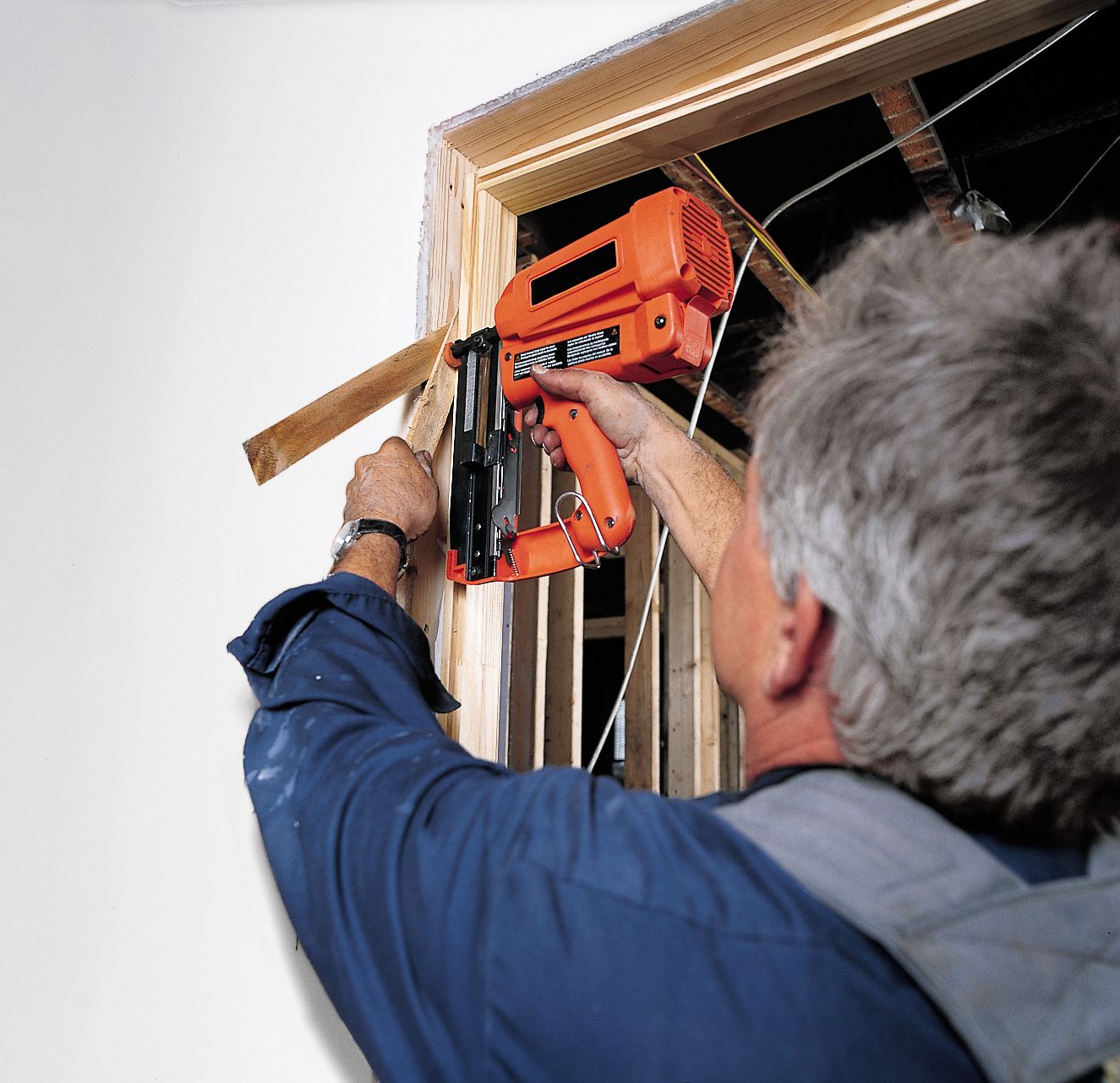
- Slip a pair of shims between main jamb on the latch side and the trimmer, near the top of the door opening. When they are just touching the back of the jamb without putting any pressure on it, nail them to the trimmer with 8d finish nails.
- Nail additional pairs of shims a few inches above the base of this jamb, as well as just above and below the strike plate. Without these shims, the jamb could flex.
5. Replace the Hinge Screw
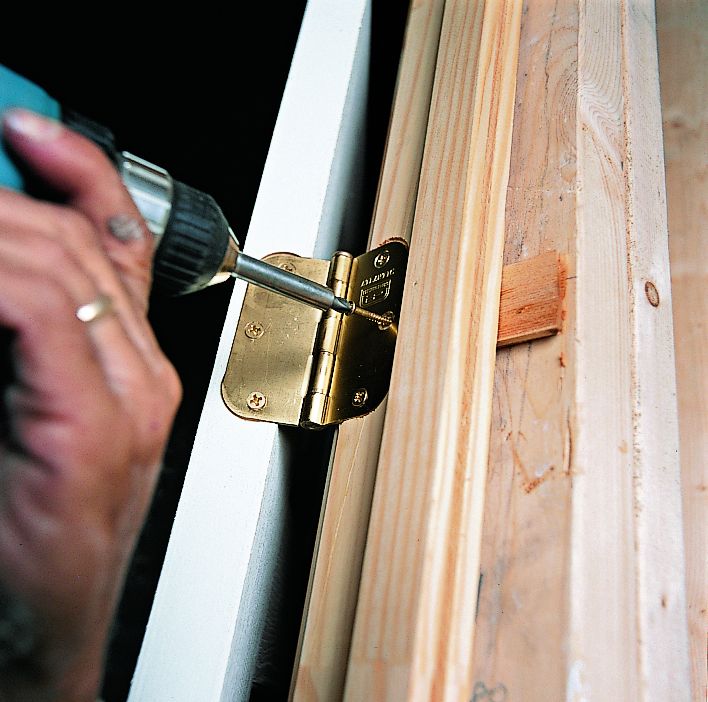
- On the hinge jamb, remove the center screw from the top hinge leaf and replace it with a screw that’s long enough to penetrate the trimmer. This prevents the door from sagging and binding.
Tip: If the long screws don’t match the ones that came with the hinges, install them behind the hinge leaf.
6. Attach the Split Jamb
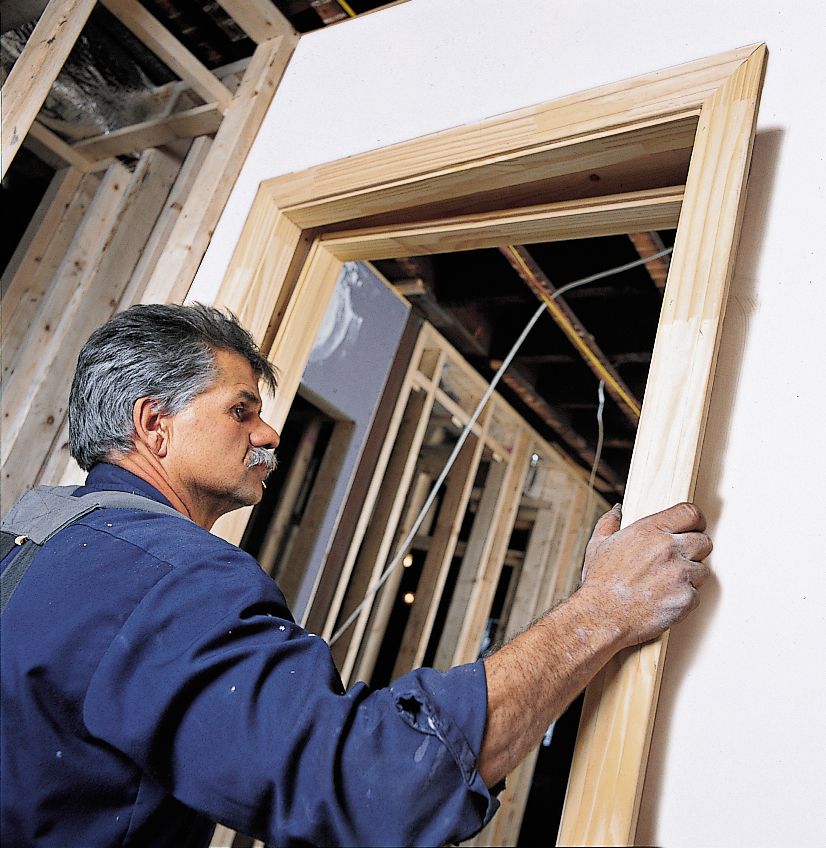
Many prehung doors come with a split jamb, which allows for easier installation and adjustment. Attaching the split jamb is the final step in securing the door frame.
- Starting at the bottom, gently push the edge of the split jamb into the groove in the main jamb.
- Work your way up, tapping the two jambs together using both hands.
- Nail the casing to the wall on both sides of each miter, and about every 18 inches along the casing.
- To hold the two jambs together, drive 8d finish nails through the stop and into the trimmers: one nail at each hinge location, one through the shims near the top and the bottom of the latch jamb, and one each just above and below the striker. Do NOT nail into the head jamb. This allows for natural expansion and contraction of the wood.
7. Mount the Latch Hardware
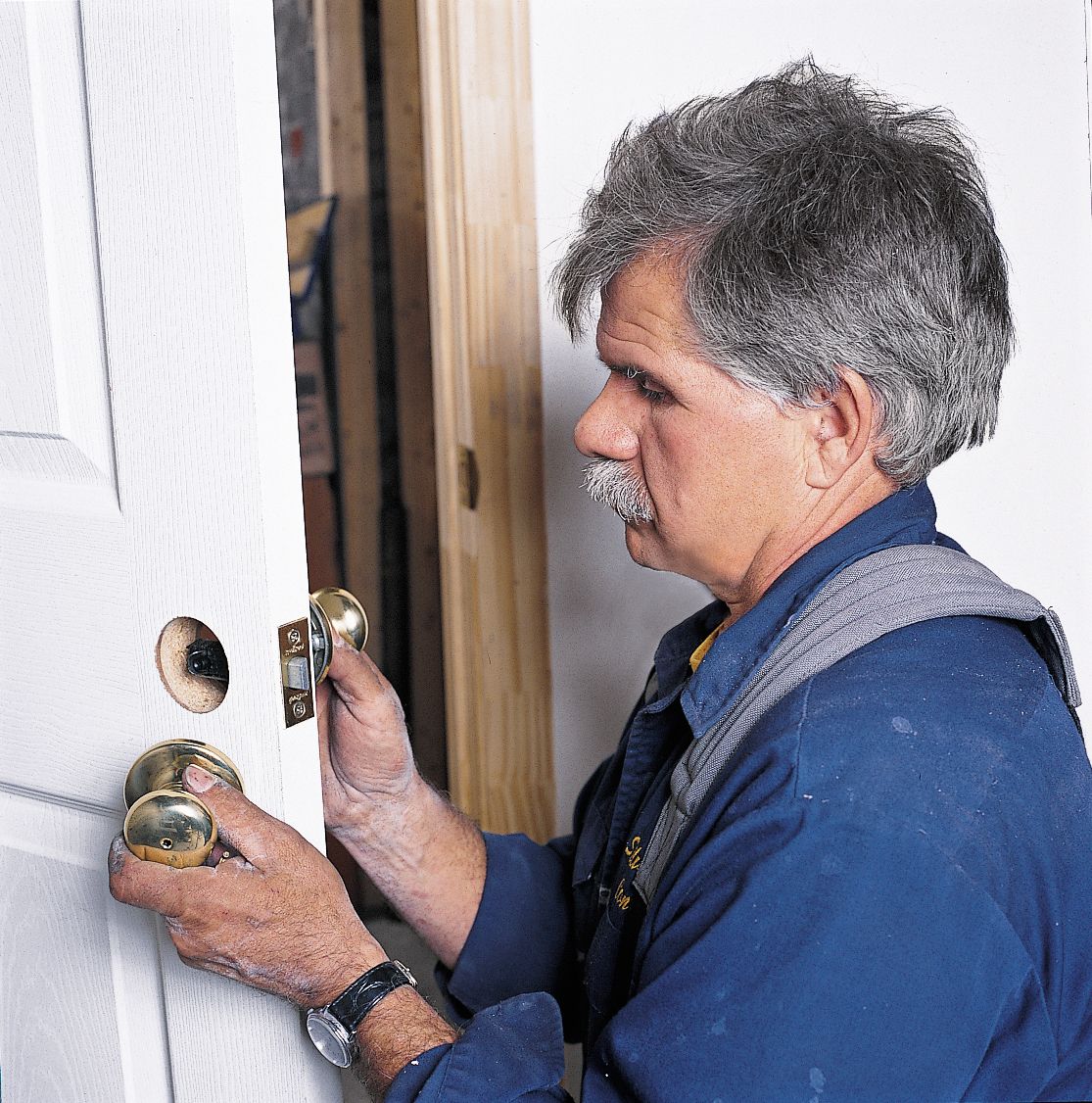
With the door securely in place, it’s time to install the hardware. This includes the strike plate, doorknob, and latch. Proper installation of these components ensures the door functions correctly and securely.
- Fasten the strike plate to the mortise in the latch jamb using the screws provided. If the plate is bigger than the mortise, put the plate on the jamb, outline it with a pencil, and chisel to the outline.
- Slip the latch bolt into its bore and fasten its plate into the mortise on the door’s edge with the screws provided. If the mortise is too tight, adjust its size in the same way as you did the strike plate.
- Fit the knobs to both sides of the latch bolt, then insert and tighten the connecting screws that hold the knobs together.
- Close the door and listen for the latch sliding into its strike. If the door rattles, bend the prong on the strike plate slightly toward the stop. If the latch doesn’t catch, bend the prong away from the stop. Tighten all the screws.
8. Finishing Touches for Prehung Door Installation
The final steps in installing a prehung door involve sealing gaps and applying any desired finishes.
Caulking and Sealing
Proper sealing prevents drafts and moisture intrusion:
- Apply a bead of caulk around the exterior trim where it meets the wall.
- Seal any gaps between the jamb and the rough opening.
- If installing an exterior door, add weatherstripping around the door frame for additional insulation.
Painting or Staining
To protect the door and enhance its appearance:
- Remove the doorknob and any other hardware.
- Sand the door and frame lightly to ensure a smooth surface.
- Apply primer if needed, then paint or stain as desired.
- Once dry, reinstall the hardware.
Remember to paint or stain all six sides of the door, including the top and bottom edges, to prevent warping.
Troubleshooting Common Issues With Prehung Doors
Even with careful installation, you may encounter some issues with your prehung door. Understanding how to address these problems can save you time and frustration.
Dealing With Out-of-Plumb Walls
When a wall is more than 1/8-inch out of plumb between the top of the opening to the floor, the door should be plumbed independently of the opening. Just plumb the hinge and latch jambs with a level or a bob and hold them in place with shims. There will be a gap between the casing and the wall, so cut a piece of wood to fill it. A split jamb can fit over a 2×4 stud wall up to 1/2 inch out of plumb. More than that and you may need to modify the jamb.
Addressing Out-of-Plumb or Non-Parallel Trimmers
Shims can make up for out-of-plumb trimmers unless they are so bad that the door doesn’t fit. If the fit is a bit too tight across the bottom (and the wall is newly drywalled), you may be able to gain 1/2-inch or so with a little pounding. Remove the screws that hold the drywall to the trimmers, then coax the trimmer ends into the wall with a sledgehammer. Toenail them back to the sole plate, cut the plate back flush using a reciprocating saw, and reattach the drywall screws. A sledge won’t work if the opening is too tight at the top or if the wall is covered with old plaster. In those cases, reframe the opening or order a smaller door.
Correcting Out-of-Square Trimmers
A framing square can tell you whether the faces of the trimmers are square to the wall surface. If they’re not, you might end up with bound hinges or uneven gaps between the door and the jamb. To correct this, add a third shim to the standard opposed pair. Slide the third shim back and forth under the other two to change their angle with respect to the trimmer. Note: If you have done this on the hinge side, double-check that all three sets of shims are plumb before installing the door.
Fixing Door Binding Problems
If your door binds or doesn’t close smoothly, here are some potential solutions:
- Check that the hinges are fully seated and all screws are tight.
- Ensure the strike plate is properly aligned with the latch.
- If the door rubs at the top or bottom, you may need to plane those edges slightly.
Addressing Latch Problems
Latch problems can be frustrating but are usually easy to fix. If the latch doesn’t catch:
- Ensure the strike plate is aligned correctly.
- Adjust the latch bolt and strike plate until they fit perfectly.
- If necessary, use a file to enlarge the hole slightly in the strike plate.
Maintenance Tips for Prehung Doors
To keep your prehung door looking and working great for years to come, follow these maintenance tips:
- Periodically check and tighten hinge screws.
- Lubricate hinges and the latch mechanism annually.
- Repaint or restain the door every few years to protect it from moisture and wear.
- Check the weatherstripping and replace it if it is worn or damaged.
- Adjust the door as needed if you notice changes in how it closes or latches.
Our Conclusion
While installing a prehung door requires attention to detail and some carpentry skills, many DIY enthusiasts can tackle it with the right guidance and tools. Measure carefully, make small adjustments, and be patient. “I started out using little more than a hammer, a chisel, and a screwdriver,” says Silva. In those days, he’d assemble the jamb, hand-cut the hinge mortises, and hang the door separately. “It took a good long time and lots of patience,” he says.
Read How to Install an Exterior Prehung Door for information on exterior door installation.

